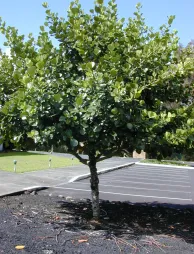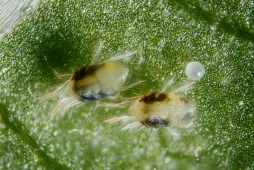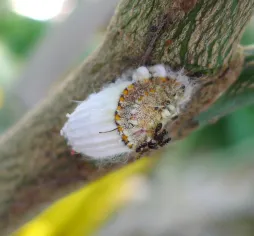Clusia major, a Clusia with white flowers
Often confused with clusia rosea, Clusia major is native to the West Indies and Trinidad. This plant, which also belongs to the Clusiaceae family, is distinguished from its cousin by its smaller size and immaculate flowers.
How to recognize Clusia major
Clusia major is a tree with a slender, spreading habit. It can reach a height of ten meters in the wild. But it doesn't exceed 2.5 meters when grown indoors in pots.
The dark-green, leathery leaves can measure over 20 centimetres in length. Their lighter midrib is very pronounced.
Clusia major rarely flowers when grown indoors. In the West Indies, the tree produces creamy-white or off-white vanilla-scented flowers. It then produces round, red berries.
Clusia major is toxic to humans and animals. Its sap contains an irritating latex. The plant causes digestive problems (notably vomiting) if ingested, and skin irritation if the skin comes into contact with its sap. Keep your shrub out of reach of young children and pets. Wear gloves when pruning or repotting.
Our maintenance tips
Clusia major are resistant to forgotten watering, but not to over-watering. Before watering, make sure the soil is dry. Also, choose a pierced terracotta pot rather than a plastic one, so that moisture doesn't accumulate at the bottom of the pot.
Watering
Keep the soil slightly moist. Water only when the substrate is dry on the surface, for one or two centimeters.
Water with non-calcareous water at room temperature, without soaking the soil.
Thirty minutes after watering, empty any stagnant water from the cup. This will keep the roots dry and prevent them from rotting.
Spray
Clusia major come from tropical regions. They appreciate high humidity. To recreate it, spray the foliage with non-calcareous water at room temperature.
Repotting
Every spring, repot your Clusia major to give it more space.
Choose a pierced pot one size larger than the previous one. Pour a drainage layer (clay balls or gravel) in the bottom.
Add a layer of potting soil for green plants. Plant your Clusia major in the center. Top up with substrate.
Tamp and water to encourage rooting.
Fertilization
To promote the growth of your Clusia major, apply fertilizer in spring and summer.
To encourage the growth of your Clusia major, add a little special houseplant fertilizer to the watering solution.
Prune
You are not obliged to trim your Clusia major. However, you can shorten the tops of stems or branches to control its growth and shape.
Always use a sharp, clean tool to promote healing and avoid spreading disease.
Cutting
Cutting is carried out during the strong growth phase, generally in spring and early summer.
Remove a lateral stem of about fifteen centimeters with clean, sharp pruning shears. The plant is toxic. Wear gloves during the operation and wash your hands afterwards.
Remove the leaves at the bottom and keep only one or two pairs at the top. You can dip the tip in cutting hormone to increase your chances of success.
In a pierced pot, pour a layer of clay balls for drainage. Add potting soil for seedlings and planting.
Using a pencil, make a pilot hole and plant your cutting.
Water at room temperature to help the plant take root.
Diseases / Threats
Information
| Family | Clusiaceae - Clusiaceae |
| Type | Clusier - Clusia |
| Species | Clusia major - Clusia major |
| Lifecycle | Perennial |
| Foliage | Evergreen |
| Exposures | |
| Substrat | |
| Planting methods |
In pots In tubs |
| Categories | |
| Tags |
Large pot Toxic |
| Origin |
South America |
| Hardiness (USDA) | 11a |
| Leaf color |
|
| Flower color |
|
Discover plants from the same family

Clusia rosea
Discover




















